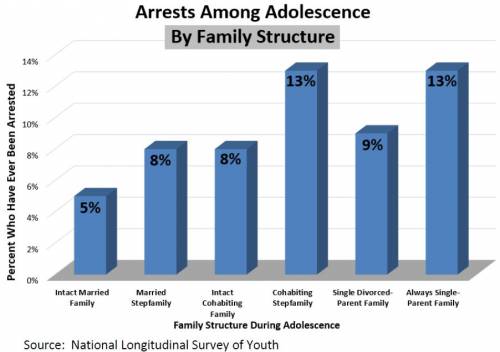Editor’s Summary: This study investigates the impact of family structure on juvenile delinquency among children at Nakuru Children’s Remand Home in Kenya. Surveying 55 juvenile offenders aged 10-18, the research analyzes various family structures, including two-parent, single-parent, stepfamilies, children’s homes, and grandparent-headed families, and their correlation with delinquent behaviors such as substance abuse, theft, truancy, sexual offenses, and violent crimes. Significant findings reveal higher substance abuse in non-intact families, increased sexual offenses in single-parent homes, and elevated truancy in grandparent-headed families. The results emphasize the complex relationship between family structure and juvenile delinquency, suggesting targeted intervention and prevention strategies.
Family Structure and Juvenile Delinquency: Insights from Kenya
Abstract
This study examined the influence of family structure on juvenile delinquency among children at Nakuru Children’s Remand Home in Kenya. A sample of 55 juvenile offenders aged 10-18 were surveyed regarding their family structure and delinquent behaviors. Family structures analyzed included intact two-parent families, single mother families, single father families, stepfamilies, children’s homes, and grandparent-headed families. Delinquent behaviors examined included substance abuse, theft, truancy, sexual offenses, and violent crimes. Correlational analyses revealed significant relationships between certain family structures and specific delinquent behaviors. Notable findings included a higher prevalence of substance abuse among children from non-intact families, increased sexual offenses among those from single-parent homes, and elevated rates of truancy among those living with grandparents. The results highlight the complex relationship between family structure and juvenile delinquency, with implications for intervention and prevention efforts.

Introduction
Juvenile delinquency remains a persistent social issue with significant consequences for youth development and public safety. A growing body of research has examined various risk factors associated with delinquent behavior among adolescents, with family structure emerging as an important variable (Demuth & Brown, 2004; Kierkus & Baer, 2002). The family unit plays a crucial role in child socialization and development, and disruptions to family structure may increase vulnerability to delinquency through various mechanisms, including reduced parental supervision, economic strain, and psychosocial stress (Amato, 2005; Thornberry et al., 1999).
While extensive research on family structure and delinquency has been conducted in Western contexts, less is known about these relationships in African settings, where extended family systems and diverse household arrangements are more common (Takyi & Gyimah, 2007). The current study aims to address this gap by examining associations between family structure and juvenile offending in Kenya.
Kenya, like many developing nations, has experienced significant social and economic changes in recent decades that have impacted family systems and youth outcomes. Rapid urbanization, high unemployment, and the HIV/AIDS epidemic have contributed to an increase in single-parent households, child-headed households, and children living with extended family members (Misigo & Kodero, 2014). Simultaneously, juvenile delinquency has become an increasing concern, with government statistics indicating a rise in youth offending rates (Government of Kenya, 2018).
This study focuses on juvenile offenders at Nakuru Children’s Remand Home, a state-run facility for children in conflict with the law. By examining the family backgrounds of these youth in relation to their offending behaviors, we aim to provide insights into the role of family structure in delinquency within the Kenyan context. Understanding these relationships can inform targeted interventions and policies to support at-risk youth and families.
The specific objectives of this study are to:
- Determine the prevalence of different family structures among juvenile offenders at Nakuru Children’s Remand Home.
- Analyze associations between specific family structures (intact, single-parent, stepfamily, institutional care, grandparent-headed) and categories of delinquent behavior.
- Compare findings on family structure and delinquency in Kenya to those reported in Western contexts.
- Identify implications for delinquency prevention and intervention efforts that account for family dynamics in the Kenyan setting.
By addressing these objectives, this research aims to contribute to the literature on family influences on youth offending in non-Western contexts and provide an empirical basis for family-focused delinquency prevention strategies in Kenya.
Work Cited
• Amato, P. R. (2005). The impact of family formation change on the cognitive, social, and emotional well-being of the next generation. Future of Children, 15(2), 75-96.
• Demuth, S., & Brown, S. L. (2004). Family structure, family processes, and adolescent delinquency: The significance of parental absence versus parental gender. Journal of Research in Crime and Delinquency, 41(1), 58-81.
• Government of Kenya. (2018). Annual Crime Report. Nairobi: Government Printer.
• Kierkus, C. A., & Baer, D. (2002). A social control explanation of the relationship between family structure and delinquent behaviour. Canadian Journal of Criminology, 44(4), 425-458.
• Misigo, B. L., & Kodero, H. M. (2014). The impact of HIV/AIDS on the family structure in Kenya. International Journal of Humanities and Social Science Invention, 3(1), 21-25.
• Takyi, B. K., & Gyimah, S. O. (2007). Matrilineal family ties and marital dissolution in Ghana. Journal of Family Issues, 28(5), 682-705.
• Thornberry, T. P., Smith, C. A., Rivera, C., Huizinga, D., & Stouthamer-Loeber, M. (1999). Family disruption and delinquency. Juvenile Justice Bulletin. Retrieved from https://www.ncjrs.gov/pdffiles1/ojjdp/178285.pdf